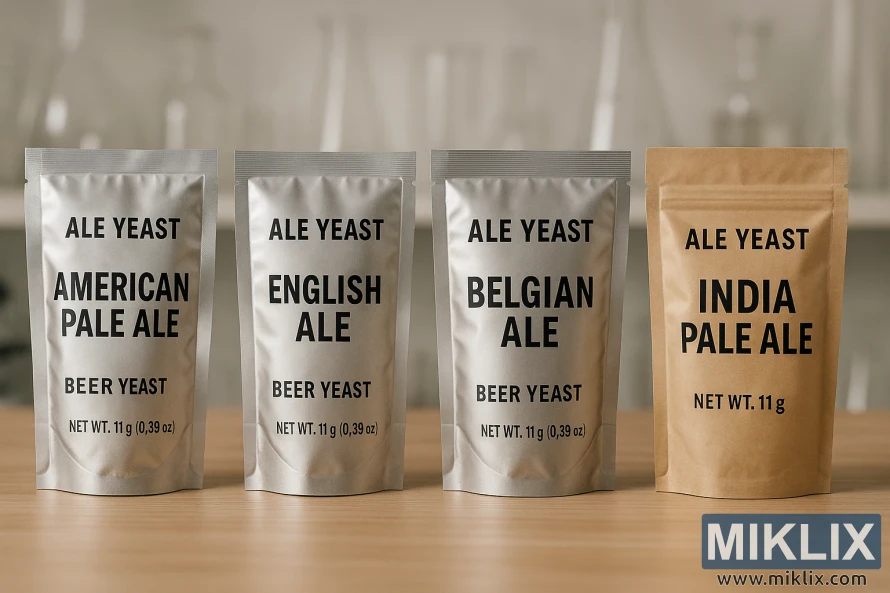Image: Ale yeast packages for homebrewing
Published: July 20, 2025 at 7:09:28 AM UTC
Last updated: September 27, 2025 at 12:54:27 PM UTC
Four commercial ale yeast packages—American, English, Belgian, and IPA—stand on wood with lab glassware blurred in the background.
On a smooth, polished wooden surface that evokes the warmth and craftsmanship of a homebrewer’s workspace, four upright packets of ale yeast stand in a clean, orderly row. Each packet represents a distinct strain tailored to a specific beer style, offering a glimpse into the nuanced world of fermentation and flavor development. The packaging is simple yet purposeful, designed to communicate clarity and function. Three of the packets are made of reflective silver foil, their surfaces catching the ambient light and adding a sleek, modern touch. The fourth, a kraft paper pouch, introduces a rustic contrast, suggesting a more artisanal or organic approach to yeast cultivation.
Bold black text on each packet announces the intended beer style: “AMERICAN PALE ALE,” “ENGLISH ALE,” “BELGIAN ALE,” and “INDIA PALE ALE.” These labels are more than just identifiers—they are invitations to explore the unique fermentation profiles and flavor characteristics that each yeast strain imparts. Beneath the style names, smaller text reads “ALE YEAST,” “BEER YEAST,” and “NET WT. 11g (0.39 oz),” providing essential details for the brewer. The uniform weight across all packets suggests consistency in dosage and application, allowing for precise control over fermentation outcomes.
The packet labeled “AMERICAN PALE ALE” likely contains a clean, neutral strain known for accentuating hop character while maintaining a crisp finish. It’s the kind of yeast that supports the bright citrus and pine notes typical of American-style pale ales, without overshadowing them. The “ENGLISH ALE” packet, by contrast, probably houses a strain that produces subtle esters and a fuller mouthfeel, ideal for traditional bitters and milds. This yeast would contribute gentle fruitiness and a soft, bready backbone, enhancing the malt-forward nature of English-style beers.
“BELGIAN ALE” yeast is known for its expressive fermentation profile, often producing spicy phenols and fruity esters that define Belgian-style beers. The strain in this packet might yield notes of clove, banana, or bubblegum, depending on fermentation temperature and wort composition. It’s a yeast that invites experimentation and rewards careful attention to process. Finally, the “INDIA PALE ALE” packet likely contains a strain optimized for high attenuation and clean fermentation, allowing bold hop flavors to shine through with minimal interference. This yeast is built for clarity, dryness, and punchy bitterness—hallmarks of the modern IPA.
In the softly blurred background, shelves lined with laboratory glassware hint at the scientific rigor behind yeast cultivation and brewing. Beakers, flasks, and a microscope suggest a space where biology and chemistry intersect with craft. The clean, professional atmosphere reinforces the idea that brewing is both an art and a science, and that even the smallest ingredient—yeast—plays a critical role in shaping the final product.
The overall composition of the image is calm and deliberate, reflecting the thoughtful nature of brewing. The packets are not just supplies—they are tools of transformation, each one containing billions of living cells ready to convert sugars into alcohol, carbon dioxide, and a symphony of flavors. The scene invites the viewer to imagine the brewing process unfolding: the careful measurement of ingredients, the monitoring of fermentation, and the anticipation of tasting a beer that reflects both tradition and personal touch.
This image is a quiet celebration of yeast’s role in brewing, showcasing the diversity of strains available to homebrewers and the precision with which they can be applied. It speaks to the empowerment of the modern brewer, who can choose from a wide array of yeast types to craft beers that are authentic, innovative, and deeply satisfying. Whether you're a seasoned brewer or just beginning your journey, these packets represent possibility—each one a gateway to a new flavor experience, a new recipe, a new story told through beer.
The image is related to: Yeast in Homebrewed Beer: Introduction for Beginners

